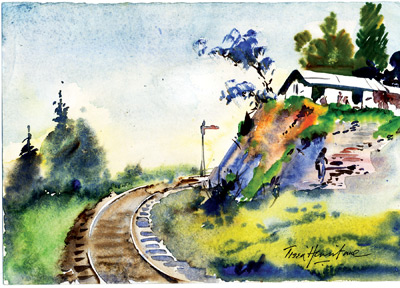The art of outdoor watercolour painting
by Tissa Hewavitarane
There is no such thing as perfect conditions for watercolour
paintings outdoor at least not according to some of the complaints and
excuses you encounter. These include the paint drying too fast, the wind
blowing your paper away, the rain darkening the sky, the paint not
drying due to darkness, changing light, and not finding any shade.
Though at times I have painted outside in most conditions, a few tips
can be given to beginners.
First and foremost, keep your equipment simple. Many artists carry an
enormous quantity of materials not necessary to paint a simple picture.
Some painters climb hills and rocks carrying heavy drawing boards and
bags packed with a lot of paints and drawing paper.
 They seem to think that the more they carry the less problems they'll
have. Nothing could be further from the truth. You should carry the
whole lot under one arm. Carry simple materials of light weight which
could be all plastic stuff. They seem to think that the more they carry the less problems they'll
have. Nothing could be further from the truth. You should carry the
whole lot under one arm. Carry simple materials of light weight which
could be all plastic stuff.
That will contain a soft pencil, seven tubes of paint, four brushes,
a plastic bottle of water, plastic palette and wooden or metal easel.
Now, a big must. Before you set out, check that you've got everything
with you. It's no good to discover you haven't filled your water bottle,
left your palette or brushes behind.
Next look for a good location and weather conditions. Windy
conditions can be most trying to temper when gusts make your paper flap
and threaten to blow all your material. Many of you will need a folding
up because I feel there is more freedom that way.
Working conditions
As to problems of a sunny day, whenever, possible try not to paint
with the sun directly on your paper. Apart from having to strain your
eyes up against the light on the paper the painting always seems to look
washed out. Painting always seems to looks washed out. When painting
watercolours mid-summer there are obvious difficulties.
We learnt to avoid working in the middle of the day with the hot sun
directly overhead. It is much cooler before than in the morning and
after five but the lighting and shadows become more interesting. Talking
of shadows, with a partly clouded sky the sun is alternately going in
and coming out, so wait for sunlight leave the rest of the painting and
concentrate entirely on the shadows.
The big difficulty with watercolours in a hot country such as ours is
the speed of drying, even in the shade. The easiest condition to work
under is a bright but overcast light.
My other favourite condition is the mist. It lends itself so well to
wet-into-wet techniques. A landscape shrouded in mist is a thing of
ethereal beauty in which colours are softened and the forms of the land
melt into pale, ghostly shapes.
The mist is actually water vapour suspended in the air. It follows
that watercolour has a natural affinity for capturing its effects.
Painting a misty landscape is not easy. There's a certain skill involved
in achieving the right degree of softness of form and colour, whilst not
allowing the picture to dissolve into a meaningless blur. The scene
shown here of a early morning mist effect by using the wet-in-wet
technique to soften the forms particularly in the distance is a hill
country place called 'Idalgashinna' a beauty spot.
It lends enchantment to the natural beauty along the sweeping regions
and in the midst of small valleys and hillocks. Notice the sleeping
quarters of the plantation workers on top of a hill and a woman climbing
the steps with a bucket of water.
The bend along the railway lines leads to the famous 'Idalgashinna'
railway station presenting one of the grandest imaginable examples of
bold mountain scenery.
Mystery
Observe the stronger tones and colours in the foreground to give the
picture a firm anchor and accentuate the softness and mystery of the
trees in the far distance. Colour applied to wet paper create soft,
misty effects. The morning mist acts as a veil on the landscape,
reducing colour and tonal contrasts.
This effect is achieved by using subdued, harmonius colours and
closely related tones. One problem is that there is no solution to rain.
It can ruin a watercolour in ten seconds flat so don't try to brave it.
Turn the painting over the moment you feel the first spot. I know it
can't always be avoided.
Advantage
A rainy day really finds a threatening sky which is very effective.
Compose your picture in terms of light and dark patterns and take
advantage of the whiteness of the paper. Do not let the dark and the
light be equally important - let one or the other dominate. People tend
to avoid painting rainy scenes on a cloudy day or a misty morning
because they imagine the scenes will be "dull".
Yet a rainy day on a cold bleak day has a stark beauty all of its
own, in which the shapes of the trees and bushes make dramatic patterns
against the rain and the sky.
A rainy day is highly effective in conveying the huge sounds of
thunder and lightning under a threatening sky. But I always believe that
you can't capture the mood of the day unless you get out there and
experience it to turn out a good watercolour painting.
|

